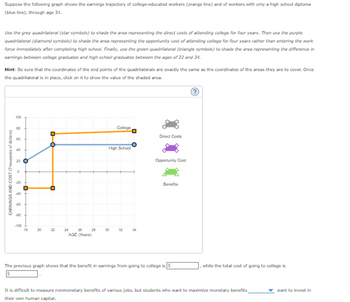
ENGR.ECONOMIC ANALYSIS
14th Edition
ISBN: 9780190931919
Author: NEWNAN
Publisher: Oxford University Press
expand_more
expand_more
format_list_bulleted
Question

Transcribed Image Text:Suppose the following graph shows the earnings trajectory of college-educated workers (orange line) and of workers with only a high school diploma
(blue line), through age 34.
Use the grey quadrilateral (star symbols) to shade the area representing the direct costs of attending college for four years. Then use the purple
quadrilateral (diamond symbols) to shade the area representing the opportunity cost of attending college for four years rather than entering the work
force immediately after completing high school. Finally, use the green quadrilateral (triangle symbols) to shade the area representing the difference in
earnings between college graduates and high school graduates between the ages of 22 and 34.
Hint: Be sure that the coordinates of the end points of the quadrilaterals are exactly the same as the coordinates of the areas they are to cover. Once
the quadrilateral is in place, dick on it to show the value of the shaded area.
?
100
8 8
8
8
EARNINGS AND COST (Thousands of dollars)
8.
8 8 8
-100
18
20
U
RS
24
AGE (Years)
College
High School
30
Direct Costs
Opportunity Cost
Benefits
The previous graph shows that the benefit in earnings from going to college is
while the total cost of going to college is
It is difficult to measure nonmonetary benefits of various jobs, but students who want to maximize monetary benefits
their own human capital.
want to invest in
Expert Solution
This question has been solved!
Explore an expertly crafted, step-by-step solution for a thorough understanding of key concepts.
This is a popular solution
Trending nowThis is a popular solution!
Step by stepSolved in 3 steps with 1 images

Knowledge Booster
Learn more about
Need a deep-dive on the concept behind this application? Look no further. Learn more about this topic, economics and related others by exploring similar questions and additional content below.Similar questions
- The accompanying table shows how total donations, average donations, total labor costs, and average labor costs vary depending on the number of employees State U hires for its fundraising activities: Number of Employees Total DonationsAverage Donations Total Labor CostsAverage Labor Costs 1 2 $ 30,000 42,426 $ 8,000 3 $ 17,321 $ 17,000 27,000 4 60,000 9,500 5 13,416 50,000 The net benefit of hiring fundraisers is largest when employees are hired. Select one: a. 1 b. 2 c. 3 d. 4arrow_forwardQUESTION 18 Use the information provided in Table 7.2 below to answer the question(s) that follow. Table 7.2 Inputs Required to Produce a Product Using Alternative Technologies Technology Units of Capital Number of Employees 16 8 12 8 6 ABCD 6222 12 20 24 Refer to Table 7.2. Which technology is the most labor intensive? Aarrow_forwardWhat is the output of the 8th worker? Group of answer choices: 0 -10 10 5arrow_forward
- Baghibenarrow_forwardMarginal Produt and Resources How would you determine the demand for a factor of production? What factors influence the supply and demand for labor? Examine how those factors impact market demand for labor. How do labor unions try to increase the demand for labor? What has made labor unions such an integral part of the workforce? What is the difference between the rates of return for a renewable and nonrenewable resource? How do the rates of return on capital and land differ between a renewable resource and nonrenewable resource? How does the growing demand for food, fuel, and export affect the market for land?arrow_forwardi will 10 upvotes.arrow_forward
arrow_back_ios
arrow_forward_ios
Recommended textbooks for you

 Principles of Economics (12th Edition)EconomicsISBN:9780134078779Author:Karl E. Case, Ray C. Fair, Sharon E. OsterPublisher:PEARSON
Principles of Economics (12th Edition)EconomicsISBN:9780134078779Author:Karl E. Case, Ray C. Fair, Sharon E. OsterPublisher:PEARSON Engineering Economy (17th Edition)EconomicsISBN:9780134870069Author:William G. Sullivan, Elin M. Wicks, C. Patrick KoellingPublisher:PEARSON
Engineering Economy (17th Edition)EconomicsISBN:9780134870069Author:William G. Sullivan, Elin M. Wicks, C. Patrick KoellingPublisher:PEARSON Principles of Economics (MindTap Course List)EconomicsISBN:9781305585126Author:N. Gregory MankiwPublisher:Cengage Learning
Principles of Economics (MindTap Course List)EconomicsISBN:9781305585126Author:N. Gregory MankiwPublisher:Cengage Learning Managerial Economics: A Problem Solving ApproachEconomicsISBN:9781337106665Author:Luke M. Froeb, Brian T. McCann, Michael R. Ward, Mike ShorPublisher:Cengage Learning
Managerial Economics: A Problem Solving ApproachEconomicsISBN:9781337106665Author:Luke M. Froeb, Brian T. McCann, Michael R. Ward, Mike ShorPublisher:Cengage Learning Managerial Economics & Business Strategy (Mcgraw-...EconomicsISBN:9781259290619Author:Michael Baye, Jeff PrincePublisher:McGraw-Hill Education
Managerial Economics & Business Strategy (Mcgraw-...EconomicsISBN:9781259290619Author:Michael Baye, Jeff PrincePublisher:McGraw-Hill Education


Principles of Economics (12th Edition)
Economics
ISBN:9780134078779
Author:Karl E. Case, Ray C. Fair, Sharon E. Oster
Publisher:PEARSON

Engineering Economy (17th Edition)
Economics
ISBN:9780134870069
Author:William G. Sullivan, Elin M. Wicks, C. Patrick Koelling
Publisher:PEARSON

Principles of Economics (MindTap Course List)
Economics
ISBN:9781305585126
Author:N. Gregory Mankiw
Publisher:Cengage Learning

Managerial Economics: A Problem Solving Approach
Economics
ISBN:9781337106665
Author:Luke M. Froeb, Brian T. McCann, Michael R. Ward, Mike Shor
Publisher:Cengage Learning

Managerial Economics & Business Strategy (Mcgraw-...
Economics
ISBN:9781259290619
Author:Michael Baye, Jeff Prince
Publisher:McGraw-Hill Education